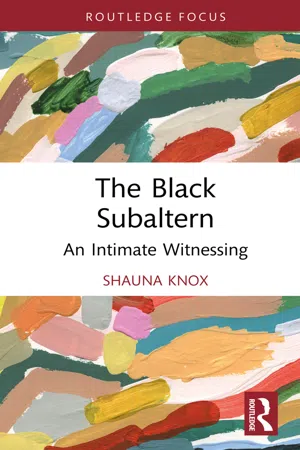On my first day of school in Jamaica, I didn’t know where I was going. I’d been to school before, but just getting dressed for this school was a whole new experience. Over my underwear, I pulled up a checkered, purple-and-white pair of bloomers, with a very noticeable elastic fastening presence around my waist, and the mid-point of my thighs. From the elastic, one more whimsical inch of fabric only served to frill its way around the circumference of each of my legs. The bloomers were a strange ligation. In my bloomers I looked like my body was a tube, and their elastic was my tourniquet, stopping the flow of all my internal elixirs so that inside of them, I was a swollen balloon. Those same purple-and-white boxes ran all over me, covering my uniform dress, which, without fanfare, looked like a sleeve that reached down to my knees and stopped suddenly, this time without the frills. Around my neck, I wore a white Puritan collar, with three small transparent buttons running down the center of my chest. The buttons laid atop a tie that was stitched onto my uniform and was also cut from the same purple-and-white grid. While I wore brown leather shoes and white socks with this same dress every day until I was ten years old, I will never forget my very first day in school. I was alone in my first-grade classroom. Half of the wall to the corridor was concrete, and the other half was a lattice of steel bars. I cried violently as I watched my mother’s figure float away from me on the other side of that grillwork, but the most horrific sinking feeling I had that day came later when I saw my aunt walking toward the classroom to check on me, except by the time she came, I was no longer crying. I knew then that I had become one of them—full, Black native, inoculated against the weakness of feeling. My family wouldn’t worry for me anymore because my aunt had seen that I could stuff my anguish like the flesh in my bloomers, and go numb.
…
My course to callousness was complicated and onerous. Before my first day of school in Jamaica, I had lived all six years of my life in the United States. I walked into a new world in that school building, with its jarring egg-green walls, the coldness of its shiny concrete floors, metal chairs, and wooden desks, accentuated by the unusual accents wafting over chests intentionally coated several times over with talcum powder. There were so many things I had never seen before. Prior to my first day, school meant reading corners, giant pillows, colorful carpets, glossy posters, and beautiful picture books. My teachers were different in Jamaica—they did not smile at me. Their eyes looked angry and remote, and I knew that if I was left with them, I’d get lost. My tears didn’t move them and no one hugged me. I was made to sit, made to regulate myself, made to stop “giving trouble”—the trouble of my crying was disconcerting to them. I was terrified. On my first day of school, I lost the language of my tears, and long before, my teachers had lost the language of their own tenderness—we were all surrounded by loss. I walked through the doors and somehow my feelings became a public nuisance, not a private right. Among them, my right to feel and express didn’t belong to me anymore—if I did that here, I was just a “naughty girl,” not a sad one. They made me obedient, and I made my feelings to obey me—I made them go away. On my first day of school, I learned that a “good Jill” can make herself stop feeling or pretend that she does not feel. I didn’t hit myself on the palm with two wooden rulers tied together as my teachers did, but I did push my pain inward in a way that felt just as violent as “Mr. Dickie.” Sadness wasn’t in our dissociative vernacular—at school we were obedient or we were punished for disturbing the unhealthy homogeneity we were never meant to escape. By my second day, I understood the purple boxes crawling all over me, crawling over all of us were there to remind us that we are not meant to be who we are. I often wonder, when my aunt looked into my eyes through the grillwork, could she see that my sadness was already gone for good?
…
In 2018, the U.S. Department of Labor released its Findings on the Worst Forms of Child Labor Report, indicating that even though 98.9% of the Jamaican population’s children are going to school, a significant number of obedient children aged 5 through 14 are also silently “engaging in the worst forms of child labor.” The US-DOL reports that “at the behest of parents or criminal leaders, referred to as ‘dons,’ [obedient children] are forced into commercial sexual exploitation. (1) Children also continue to be recruited by criminal organizations to engage in illicit activities, such as gang violence, guns and drug smuggling, and financial fraud, including lottery scamming (1; 13; 16). Child domestic workers may be subjected to domestic servitude, and some children are subjected to forced begging.” The cost of being refused their feelings and thereby refusing to feel is that without feelings, we are less than human and can be made to do anything. If society fails to see every human as a feeling being, some humans will be made more vulnerable to abuse. The colonized society dehumanizes its children because it is a place in which humanity cannot survive.
